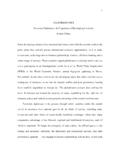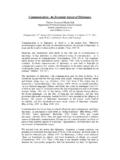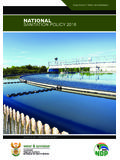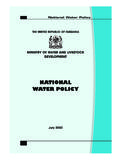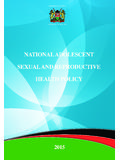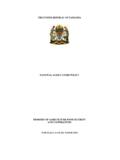Transcription of Policy Brief - CUTS CITEE
1 Policy BriefPolicy BriefNovember 2015 Issue 2tremendously significant to combine the water Policy practices with the sustainability issue for the sake of long-term Policies for water ManagementBangladesh has various national policies for different key sectors to accelerate the balanced way of development. There are several policies and acts for formulating the rules and regulations on general usage on water . The major policies and acts are: a. national water Policy (1999); b. Coastal Zone Policy (2005); c. Coastal Development Strategy (2006); d. national water Management Plan: Development Strategy (2011); e. Bangladesh water Act 2013. national water Policy (1999)The national water Policy was initiated at 1999 as the key guideline of the water usage for the first time after the birth of the state at 1971. Ministry of water Resources generally implements all the activities co-ordained with the water Policy for ensuring the proper usage of the scarce water resources.
2 national water Policy has some specific sector-oriented goals which are actually the key to achieve segmented success as a part of sustainable water usage1. In this Policy , some distinctive features of existing water mechanism along with some most drastic challenges are noted by the authority. The pragmatic features identified are: Private users of water as principle agents for development; Necessity of the active promotion of private sector for developing water management; Development of water resources through large and lumpy capital investment; water Management in Bangladesh*Public Policy is the basic printout of completing the whole general responsibilities of any independent state so that each and every prime sector of a state should have specific Policy by which a state can run progressively. As many other states of the world, Bangladesh has many sector-specific public policies for doing welfare activities for the people such as agricultural Policy , water Policy , energy Policy etc.
3 As life in riverine Bangladesh is based on water , physical availability and accessibility of water are basic human rights which are expected to be done through the national water Policy . Unfortunately, Bangladesh did not have any water Policy at the very early stage after independence. All the activities used to be conducted on the basis of the country s experience and expediency at that period. However, after realizing the fact that, water is not an infinite bounty of nature, rather it is a finite and scarce resource, the necessity of a sound water Policy then came in front of the political authority of the state. Then the first national Policy was initiated in 1999, after 27 years of the independence. Subsequently, water law, management Policy and Policy options for various significant sectors were enacted by the government. As water is one of the most necessary natural resources for a specialized country of agriculture like Bangladesh, the issue of sustainability comes sharply in this specific matter.
4 Basically, water sustainability means fulfilling the demand of usable water for the present generation without compromising the demand of future generation. But the existing picture is not so identical with the concept of sustainability. Hence, it is * The Policy Brief is prepared by Dr. Mahfuz Kabir and Priangka Das. The authors are grateful to Dr. Veena Vidyadharan and Ms. Susan Mathew of SDIP project for their valuable comments and national water Policy (1999), Ministry of water Resources, Government of Bangladesh. 1 Policy Brief international conventions and treaties including to achieve the targets of the Millennium Development Goals (MDGs)Coastal Development Strategy (2006)It is built on different sector policies of the Government of Bangladesh. The Policy states that the coastal development process aims to comply with the national Goal for Accelerated Poverty Reduction (PRSP); the Millennium Development Goals (MDGs), the Code of Conduct for Responsible Fisheries and with other international conventions and treaties.
5 The prime goal of the CZ management is to create conditions, in which the reduction of poverty, development of sustainable livelihoods and the integration of the CZ into national processes can take place. The basic development strategies are following- economic growth, basic needs and opportunities for livelihoods, reduction of vulnerabilities, sustainable management of natural resources, equitable distribution, empowerment of communities, women s development and gender equity, conservation and enhancement of critical ecosystems water Management Plan: Development Strategy (2011) Bangladesh embarked upon preparation of a national water Management Plan (NWMP). In the course of this, a Development Strategy for the NWMP was subsequently adopted in June 2001. In accordance with Policy and the Development Strategy, this national water Management Plan has been prepared to provide a framework at national and regional level within which line agencies, local Government and other stakeholders may plan and implement their own activities and projects in a coordinated manner, consistent with overall national and sectoral water Act 2013It is an act to make provisions for development, management, abstraction, distribution, use, protection and conservation of national resources in an integrated approach.
6 The act is applicable for the surface water , ground water , sea water , rain water and water in the atmosphere in the territory of Bangladesh. For the purpose of this act a small council which is called national water Resource Council presided by the Prime Minister has been constituted. Under this act, several exchange can be possible at government level. Those are: Exchange and assess any information of common water resources; Economies of scale justifies public sector involvement; Urgency to satisfy multi-sector water needs with limited resources; Delineating public and private water Policy (1999) document unequivocally expounded six main objectives:a) Development of all forms of surface and ground water management through equitable manner;b) Ensuring the availability of water to all level people of the society emphasizing on women and children;c) Accelerating sustainable public and private water delivery systems with legal and financial measures;d) Bringing institutional changes to decentralize the water management and to enhance the role of women;e) Formulating a legal and regulatory environment in water management systems.
7 F) Developing a state of knowledge to design future water resource management plans with economic efficiency and social Zone Policy (2005)The coast of Bangladesh is known as a zone of vulnerabilities as well as opportunities. It is prone to natural disasters like cyclone, storm surge and flood. The combination of natural and man-made hazards, such as erosion, high arsenic content in ground water , water logging, earthquake, water and soil salinity, various forms of pollution, risks from climate change, etc, have adversely affected lives and livelihoods in the coastal zone and slowed down the pace of social and economic developments in this region. The Government, therefore, has formulated this coastal zone Policy (CZP) that would provide a general guidance to all concerned for the management and development of the coastal zone in a manner so that the coastal people are able to pursue their life and livelihoods within secure and conducive environment.
8 The CZP, was approved at the cabinet meeting on January 17, 2005 (MoWR 2005). This Policy document was formulated through a process of multi-level consultation over a period of two years. The coastal development process aims to meet, on an overall basis, national Goal for Economic Growth, Poverty Reduction & Social Development, Code of Conduct for Responsible Fisheries, Code of Conduct for Responsible Mangrove Management and other 2 Policy Brief translate the national water Policy into 84 programs within the framework of Integrated water Resources Management (IWRM).River Research Institute (RRI)River Research Institute (RRI) is a national organization working as a statutory public authority under the Ministry of water Resources, Government of Bangladesh. It consists of three directorates: Hydraulic Research, Geotechnical Research, and Administration & Rivers Commission (JRC) It was established on 19 March 1972 in Dhaka.
9 The functions of JRC are: to maintain liaison between the participating countries in order to ensure the most effective joint efforts in maximizing the benefits from common river systems to both the countries; to articulate flood control works and to recommend implementation of joint projects; to formulate detailed proposals on advance flood warnings, flood forecasting and cyclone warnings; to study flood control and irrigation projectsGap between Policy and PracticeThe water Policy initiated in 1999 which is almost 16 years ago from now. As the bigger context problems always change those mechanisms, updating the Policy by keeping pace with the time is a must. But in this case, this issue is absent. The Quick Diagnostic Study (QDS), which was conducted primarily under Sustainable Development Investment Portfolio (SDIP), has identified various issues such as decreasing water flow in the river, lack of water supply infrastructure in the rural area, preventing water pollution in every level, preservation of water bodies, irrigation management which are covered by the national water Policy (1999).
10 The issue of integrated river basin management is properly identified in Policy but it has some specific problems in implementation level. These are- Inadequate co-operation among different institutes; Gap in the knowledge sharing process among the SAARC countries; Inefficient co-operation of the river sharing countries. For another significant issue, efficient use of water , the observation from field level is that common people are not aware enough about the importance of it. A very much required concern, lack of capital to buy irrigation equipment, is not properly addressed in the existing policies and strategies. It is the high time to include these issues into the policies. As a result, co-ordination Joint research on international rivers; Prevention measures for chemical and organic pollution; Measures for the distribution of the water of international rivers; Organization of educational and training programs on water Authorities of WaterThere are some regulatory authorities to implement and supervise the noted activities according to various policies and acts on water .
